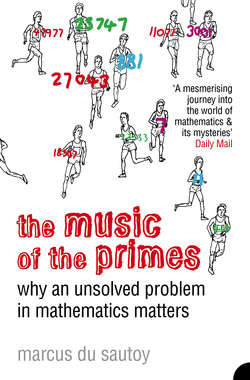The Music of the Primes: Why an unsolved problem in mathematics matters

Реклама. ООО «ЛитРес», ИНН: 7719571260.
Оглавление
Marcus Sautoy du. The Music of the Primes: Why an unsolved problem in mathematics matters
The Music of the. Primes Why an Unsolved Problem in Mathematics Matters
Copyright
Praise
Dedication
Contents
CHAPTER ONE. Who Wants To Be a Millionaire?
CHAPTER TWO. The Atoms of Arithmetic
The search for patterns
Proof, the mathematician’s travelogue
Euclid’s fables
Hunting for primes
Euler, the mathematical eagle
Gauss’s guess
CHAPTER THREE. Riemann’s Imaginary Mathematical Looking-Glass
Imaginary numbers – a new mathematical vista
Looking-glass world
The zeta function – the dialogue between music and mathematics
Rewriting the Greek story of the primes
CHAPTER FOUR. The Riemann Hypothesis: From Random Primes to Orderly Zeros
Primes and zeros
The music of the primes
The Riemann Hypothesis – order out of chaos
CHAPTER FIVE. The Mathematical Relay Race: Realising Riemann’s Revolution
Hilbert, the mathematical Pied Piper
Landau, most difficult of men
Hardy, the mathematical aesthete
Littlewood, the mathematical bully boy
CHAPTER SIX. Ramanujan, the Mathematical Mystic
Cambridge culture clash
CHAPTER SEVEN. Mathematical Exodus: From Göttingen to Princeton
Rethinking Riemann
Selberg, the solitary Scandinavian
Erdos, the wizard from Budapest
Orderly zeros mean random primes
Mathematical controversy
CHAPTER EIGHT. Machines of the Mind
Gödel and the limitations of the mathematical method
Turing’s miraculous machine of the mind
Cogs and pulleys and oil
From the chaos of uncertainty to an equation for the primes
CHAPTER NINE. The Computer Age: From the Mind to the Desktop
The computer – the death of mathematics?
Zagier, the mathematical musketeer
Odlyzko, the calculating maestro of New Jersey
CHAPTER TEN. Cracking Numbers and Codes
The birth of Internet cryptography
RSA, the MIT trio
A cryptographic card trick
Throwing down the gauntlet of RSA 129
New tricks on the block
Head in the sand
Hunting for big primes
The future’s bright, the future’s elliptic
The joys of Chaldean poetry
CHAPTER ELEVEN. From Orderly Zeros to Quantum Chaos
Dyson, the frog prince of physics
Quantum drums
Fascinating rhythm
Mathematical magic
Quantum billiards
42 – the answer to the Ultimate Question
Riemann’s final twist
CHAPTER TWELVE. The Missing Piece of the Jigsaw
Speaking in many tongues
A new French Revolution
The last laugh
If you enjoyed Music of the Primes, check out these other great Marcus du Sautoy titles
Acknowledgements
Further Reading
Websites
Illustration and Text Credits
Index
P.S
About the Author. Portrait of Marcus du Sautoy
SNAP SHOT
Top Ten Favourite Books
About the Book. A Critical Eye
Jerzy Grotowski
Read On. If You Loved This, You’ll Like …
Find Out More
About the Author
About the Publisher
Отрывок из книги
Marcus du Sautoy
‘A gripping, entertaining and thought-provoking book. Du Sautoy is certainly a brilliant storyteller and introduces us to some great personalities … Even if you don’t understand the maths, this is still a fascinating book. And if you do understand some of it, it will have you running for your calculator as you try to work out some of the riddles along the way’
.....
Fermat’s numbers have failed to throw up more than four primes to date, but he had more success in uncovering some of the very special properties that prime numbers have. Fermat discovered a curious fact about those prime numbers that leave remainder 1 on division by 4 – examples are 5, 13, 17 and 29. Such prime numbers can always be written as the sum of two squares – for example, 29 = 22 + 52. This was another of Fermat’s teases. Although he claimed to have a proof, he failed to record much of the details.
On Christmas Day, 1640, Fermat wrote of his discovery – that certain primes could be expressed as the sum of two squares – in a letter to a French monk called Marin Mersenne. Mersenne’s interests were not confined to liturgical matters. He loved music and was the first to develop a coherent theory of harmonics. He also loved numbers. Mersenne and Fermat corresponded regularly about their mathematical discoveries, and Mersenne broadcast many of Fermat’s claims to a wider audience. Mersenne became renowned for his role as an international scientific clearing house through which mathematicians could disseminate their ideas.
.....